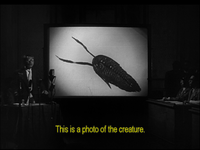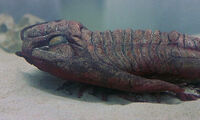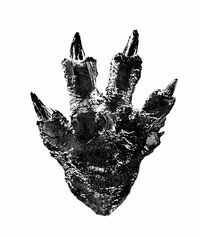A Trilobite (三葉虫 San'yōchū?) is a real-life class of extinct prehistoric marine arthropod that are closely related to chelicerates (the class of arthropods that include arachnids and horseshoe crabs)[1] that lived from the early Cambrian period until the end of the Permian. Trilobites are among the most famous fossilized invertebrates, and specimens have been found on every continent. Trilobites made appearances in the Godzilla franchise, first appearing in the 1954 Toho film, Godzilla, and played a minor role in the 2002 Toho film Godzilla Against MechaGodzilla.
Name[]
The term 'Trilobite,' meaning "three lobes," refers to the organism's structure.
Design[]
Appearance[]
Trilobites have an exoskeleton which is divided into three lobes. When alive, Trilobites bore a resemblance to the still-extant Horseshoe crab.
History[]
Showa era[]
Godzilla (1954)[]

During the Odo Island expedition in 1954 headed by Kyohei Yamane, a perfectly intact Trilobite that had somehow survived to the present day was discovered embedded in a huge radioactive footprint. After further study, Yamane concluded that the Trilobite, and potentially numerous other prehistoric lifeforms such as Godzilla, escaped extinction by surviving in deep isolated underwater pockets for millions of years. This particular Trilobite had been living in the same underwater pocket as Godzilla when the Castle Bravo hydrogen bomb test conducted at Bikini Atoll completely destroyed its habitat and drew Godzilla to the surface, with the Trilobite stuck to the bottom of his foot.
Millennium Series[]
Godzilla Against MechaGodzilla[]

The cybernetic "Mecha-Trilobite" in Godzilla Against Mechagodzilla
In 1999, scientist Tokumitsu Yuhara had successfully created a cybernetic Trilobite. Using living nerves and tissue from Horseshoe crabs along with robotic components and special "DNA computers," Yuhara perfectly replicated the extinct arthropod, which moved and behaved as if it were alive. Yuhara intended to use this method to preserve extinct and endangered species. When the Japanese government learned of Yuhara's work, it recruited him to use his method to cybernetically revive the original Godzilla as a battle machine dubbed Kiryu, so it could fight the current Godzilla.
Trivia[]

- In the concept art of Godzilla's foot released for Godzilla: Resurgence, a Trilobite can be seen stuck to the bottom of his foot, a reference to the Trilobite's appearance in the original film.
- Several kaiju bear a resemblance to the Trilobite, most notably Destoroyah's microscopic forms, and Shockirus, a fictional species of marine arthropod.
- The monsters known as the Trilopods which appear in the comic series Godzilla: Rulers of Earth are likely partially named after the Trilobite.
